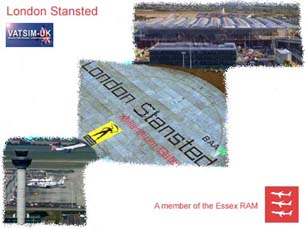|
Stansted home |
 |
|
Stansted home |
 |
Welcome to London Stansted - whether you are planning to make a career as a virtual ATCO in the Essex RAM group, or as a virtual pilot flying in or out of London's fastest growing airport.
We'll start with some history and some facts and figures.
London Stansted - owned by BAA plc, started life as an American airfield built in 1942 as the mighty USAAF bombers waged a massive campaign of destruction against targets in Nazi occupied Europe. The 344th Bomb Group and their B-26 Marauders were the main inhabitants, but once they departed for mainland Europe, Stansted returned to its original designation of tactical air depot. The RAF took over from the USAAF, and some Dakota and Halifax services were run by enterprising privateers. The US however had ideas for long range bases, and they extended the runway to over 10,000' - and in doing so left a legacy that would eventually push Stansted into the limelight. Operators, both passenger and cargo, came and went until in 1982 Air Anglia launched a Norwich and points north service, expanding the following summer. Eventually and after a problematic beginning Anglia became Air UK, and slowly developed a route network, attracting other carriers into what had then been announced as the third London airport. One of the major employers on the site - FLS Aerospace as they are now, also took up residence in the landmark Diamond Hangar where they remain to this day.
Today, Stansted is the undisputed home of the so called budget operators - with Ryanair, Buzz, and the recently married Easy/Go combination. A large number of European destinations are served by these carriers, as well as most domestic airports. Scheduled services to the US remain unsustainable despite two efforts in the last ten years, but Cargo operations are flourishing - led by the giant FedEx organisation. Some of the less known services are to Luxembourg with Luxair, Guernsey with Aurigny, and Eindhoven with KLM Exel.
The award-winning Sir Norman Foster designed terminal building has recently been expanded, and further aprons, stands and satellite terminals added to cope with the push to 25 million passengers per annum (mppa). In the summer of 2002, Stansted emerged as the likely leading candidate for southeast England's new runway capacity - with proposals for two, three or even four runways to form a new hub airport to rival or replace Heathrow.
Stansted therefore offers itself as a progressive airport with a level of service that lends itself well to simulated flight and ATC activities, at a scope suitable for novices, whilst being challenging enough to keep the veterans on their toes, whether you are behind the radar screen or the flight controls.
| London Stansted
- IATA Code STN, ICAO Code EGSS Runway 23/05 - 3048 x 46m , ILS DME Cat III equipped 110.50 MHz Runway 05 I-SED; Runway 23 I-SX Stansted NDB (SSD) 429kHz Separate Helicopter landing area Stansted Control Zone and Control Area (CTZ/CTA) is Class D airspace Transition Altitude 6000 ft |
|||||||||||||||
|
Please read the separate documents for pilots and ATC at Stansted to find out more information. Don't forget to check out the Stansted Procedures at the Vatsim-UK website under the London FIR section - recent news about all the Essex RAM airports will be found at the Essex website.
We hope you enjoy your time at Stansted in the virtual world, be it from the cockpit or behind the radar screen - or even both if you have the time!!
The Essex gang!